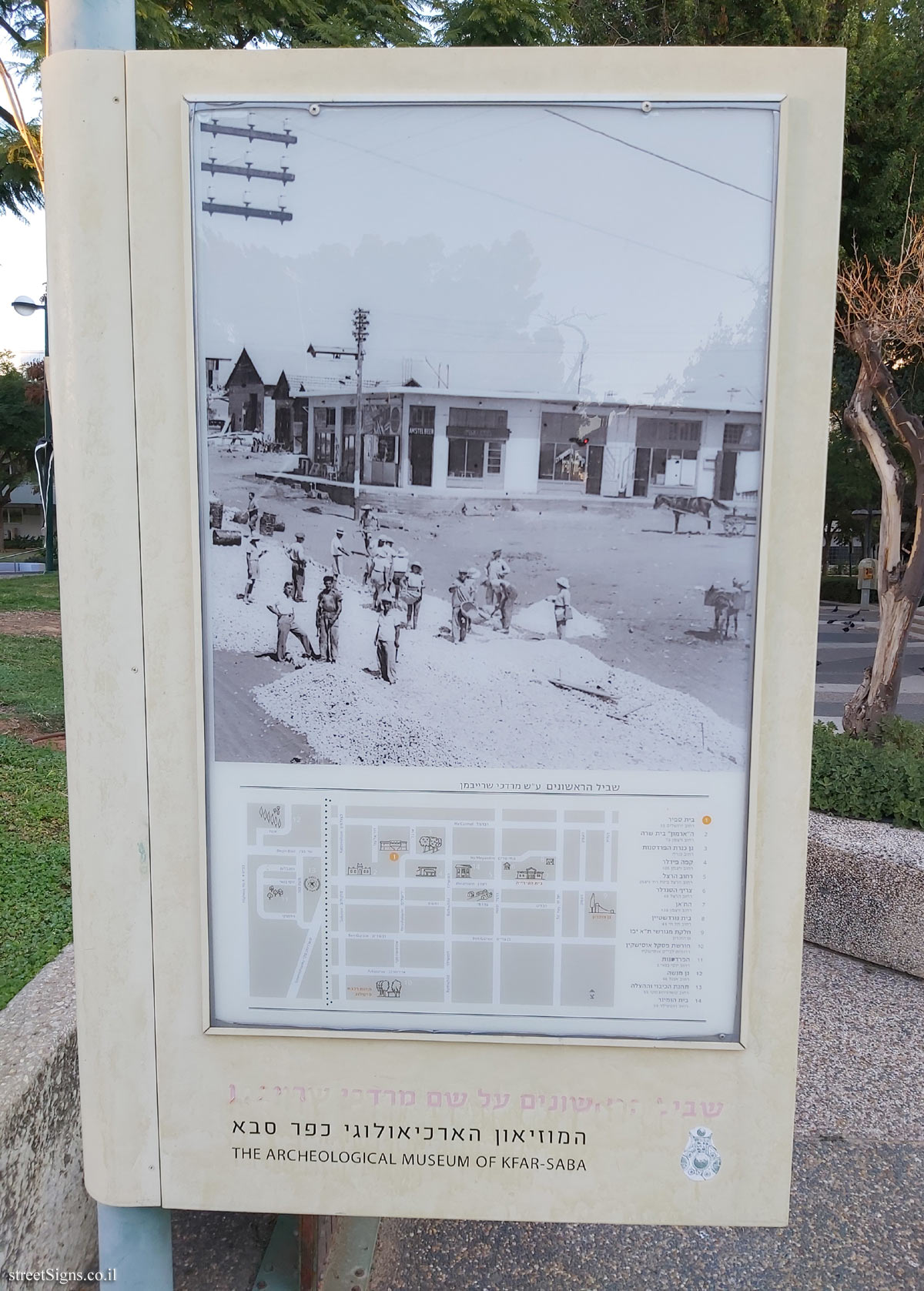On the sign:
[תמונה: רחוב הרצל]
[מפת השביל]
[הצד השני של השלט]
רחוב הרצל - הרחוב הראשון
Herzel Street - The First Street
עד שנת 1912, בעלי הקרקעות הראשונים בכפר-סבא, שהתגוררו למעשה בפתח-תקווה, לא התכוננו להקים את בתיהם במקום, אלא העסיקו בשדותיהם ובמטעיהם פועלים שכירים-יהודים ובעיקר ערבים.
בעקבות תקרית חמורה שהתחוללה בשנת תר"ע (1910) ועוררה התרגשות רבה בארץ-ישראל בפרט ובעולם היהודי בכלל, הוחלט להפוך את כפר-סבא ליישוב קבע. בתקרית, ערבים תקפו יהודים, הרסו ובבזו כל מה שנתקלו בו ונטלו את השומר אוסטרובסקי ואת אחד הצעירים, חיים סוסנובסקי לקלקיליה ורק לאחר משא-ומתן עם נכבדי קלקיליה, שוחררו השניים.
באותה שנה הוחלט להעניק הלוואה למתיישבי כפר-סבא, בסיוע חברת ’עזרא’ מברלין, לשם בניית שנים-עשר בתים. ההלוואה תוחזר בתשלומים במשך עשרים שנה ובכסף ייבנה לכל מתיישב משק בגודל חמישה דונם, ובו בית ורפת.
את ’מקום המושבה, תכנן המהנדס סלור. הוא חילק את השטח לחמישה חלקים וביניהם ארבעה רחובות, הנמשכים מצפון לדרום. לרחוב שנבחר על-ידי המתיישבים הראשונים קראו רחוב הרצל, וכמנהג הימים ההם, מחוסר רישיונות בנייה, הוסוו תחילה הבתים כרפתות.
הדרך שחצתה את השטח ממזרח למערב נקראה רחוב השרון-ויצמן. שנים-עשר הבתים הראשונים היו חד-קומתיים, ובכל בית שני חדרים, מטבח ומרפסת. הקמת הבתים הראשונים הסתיימה בגאבי תרע"ג וסוף סוף הייתה כפר-סבא למושבה.
כותב בן-גוריון בעיתון "האחדות": :אי לזאת עיבדו הצעה להושיב כאן 12 פועלים בתנאים הללו: לתת לכל פועל הלוואה של 2000 פראנק בשביל בית ורפת ומגרש של חמישה דונמים..."
בעלי הבתים הראשונים ברחוב הרצל: יצחק שיינפין, דב סקיבין, בן ציון זטלר, נתן רפפורט, דב ויינברג, אליעזר נלקין, אברהם קמינסקי, יהושע וישני, יוסף וחיים סוסנובסקי (2), ברוך פריבר, יואל וברוך אברוצקי.
התושבים שגרו במושבה בימי המלחמה: אליהו אוסטשינסקי, ישראל אנצ’יקובסקי, צבי רייזנבך, דוד לוונברג, משה נטע לוי, אריה חיימוביץ, מש’ אוסטרובסקי (אשר ואהרון), צבי אריה סלור, שכטר זונדל, בכור מזרחי, זליוונסקי יוסף.
Until 1912, the first owners af Kfar Saba land lived in Petah Tikva, and they had no intention of building their homes here. Rather, they hired workers, Jewish but mainly Arab, to work their fields and their groves.
Following a very serious incident in 1910 that aroused great emotions in Eretz Israel in particular, and in the Jewish world in general, it was decided that Kfar Saba would become a permanent settlement. In this incident, Arabs attacked Jews, destroyed and plundered everything they came across and carried off the guard, Mr. Ostrovsky, and one of the young people, Haim Sosnovsky, to Kalkilya. After negotiations with the distinguished leadership of Kalkilya, they were released. In that same year, and with the assistance of the "Ezra" Company from Berlin, a loan was granted to Kfar Saba’s settlers for the construction of 12 homes. The loan would be returned in payments Over 20 years and would give each settler a farm of 5 dunams. with a house and a barn.
The "place for the colony" was planned by Engineer Slor. He divided the area into five sections, with four streets between them. These streets run from north to south. The street chosen by the first settlers was Herzl Street, and as was the practice in those days, with no building permits, the homes first built were barns. The road dividing the area from east to west was called Sharon-Weizmann Street. The first 12 homes were one storey buildings; each house had two rooms, a kitchen and a porch.
The construction of the first homes was completed in 1913 and Kfar Saba finally became a colony. In the Ha’Achdut newspaper, Ben Gurion wrote: "The proposal was therefore accepted to settle 12 workers here under the following conditions: Each worker will be given a loan of 2000 francs for a house and a barn on a lot of five dunams...."
The first home owners on Herzl Street were: Yitzhak Sheinfein, Dov Skivin, Ben Zion Zetler, Natan Rappaport, Dov Weinberg, Eliezer Natkin, Avraham Kaminsky, Yehoshua Vishany, Yosef and Haim Sosnovsky (2), Baruch Priver, Yoel and Baruch Avrutzky.
Residents who lived in the settlement when the First World War broke out: Eliahu Ostoshinsky, Israel Antzikovsky, Zvi Reisenbach, David Leenberg, Moshe Netta Levy, Aryeh Haimovitz, The Ostrovsky family (Asher and Aharon), Zvi Aryeh Slor, Zundel Shechter, Bachor Mizrachi, Yosef Zelivansky.
סמל העיר כפר סבא
סמל מוזיאון כפר סבא
שביל הראשונים על שם מרדכי שרייבמן
המוזיאון הארכיאולוגי כפר-סבא
ירושלים 35 כפר-סבא
טלפון 09.7640867
THE ARCHAEOLOGICAL MUSEUM OF KFAR-SABA
www.kfar-saba-museum.org

 Click for a larger image
Click for a larger image  Click for a larger image
Click for a larger image  Click for sign's details
Click for sign's details